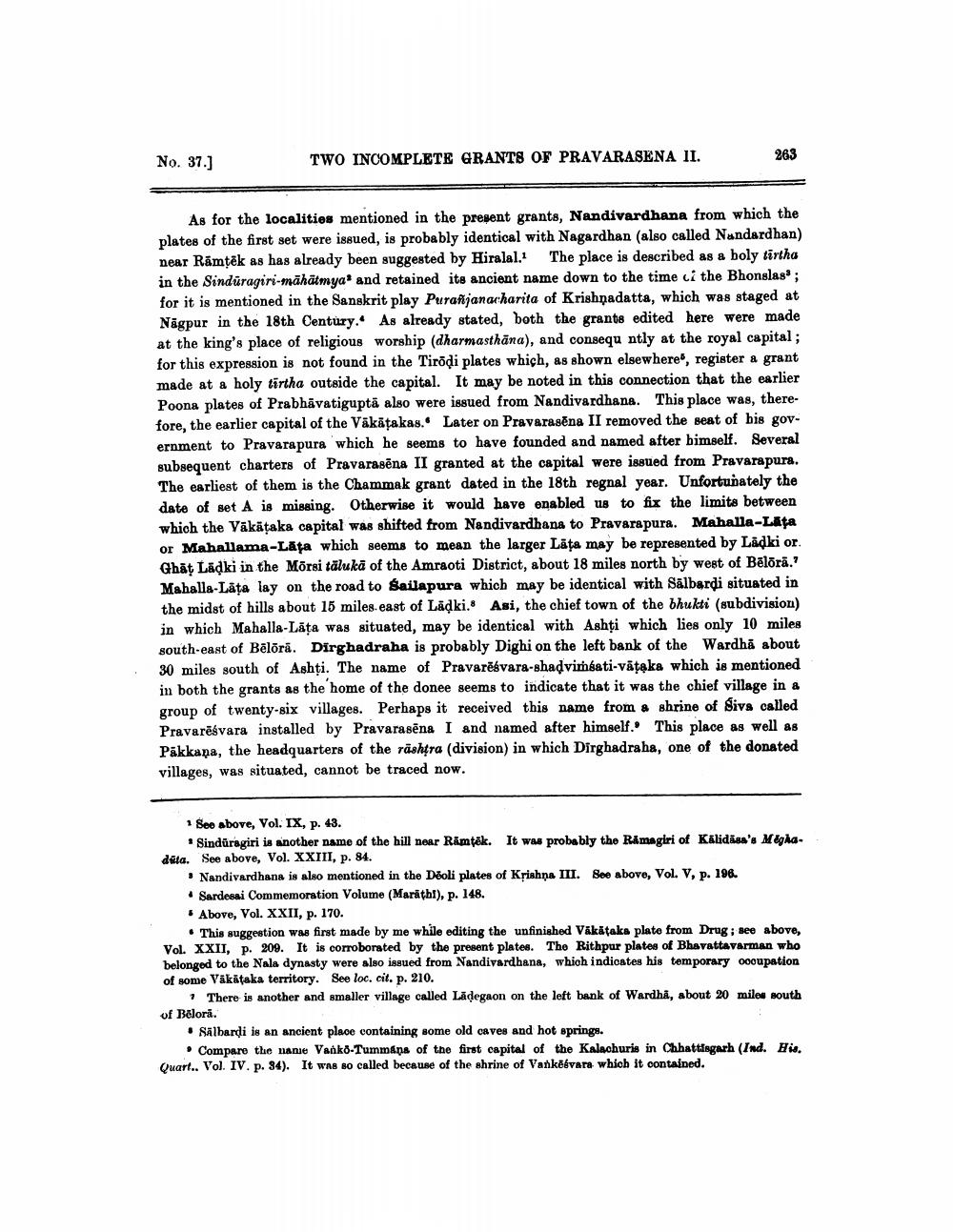________________
No. 37.)
TWO INCOMPLETE GRANTS OF PRAVARASENA II.
263
As for the localities mentioned in the present grants, Nandivardhana from which the plates of the first set were issued, is probably identical with Nagardhan (also called Nandardhan) near Rāmţēk as has already been suggested by Hiralal. The place is described as a boly tirtha in the Sinduragiri-māhātmya* and retained its ancient name down to the time ci the Bhonslas; for it is mentioned in the Sanskrit play Purañjanacharita of Krishnadatta, which was staged at Nāgpur in the 18th Century. As already stated, both the grants edited here were made at the king's place of religious worship (dharmasthāna), and consequ ntly at the royal capital; for this expression is not found in the Tirodi plates which, as shown elsewhere, register a grant made at a holy tartha outside the capital. It may be noted in this connection that the earlier Poona plates of Prabhävatigupta also were issued from Nandivardhana. This place was, therefore, the earlier capital of the Vakatakas.. Later on Pravarasēna II removed the seat of his gov. ernment to Pravarapura which he seems to have founded and named after bimself. Several subsequent charters of Pravarasēna II granted at the capital were issued from Pravarapura. The earliest of them is the Chammak grant dated in the 18th regnal year. Unfortunately the date of Bet A is missing. Otherwise it would have enabled us to fix the limits between which the Väkäţaka capital was shifted from Nandivardhana to Pravarapura. Mahalla-Lata or Mahallama-Lata which seems to mean the larger Läta may be represented by Ladki or Ghāt Ladki in the Mõrsi tāluka of the Amraoti District, about 18 miles north by west of Bēlērā. Mahalla-Lata lay on the road to Sailapura which may be identical with Salbardi situated in the midst of hills about 15 miles east of Ladki. Asi, the chief town of the bhukti (subdivision) in which Mahalla-Lāța was situated, may be identical with Ashti which lies only 10 miles south-east of Bēlārā. Dirghadraha is probably Dighi on the left bank of the Wardhă about 30 miles south of Ashți. The name of Pravarēsvara-shadvimbati-văţaka which is mentioned in both the grants as the home of the donee seems to indicate that it was the chief village in a group of twenty-six villages. Perhaps it received this name from a shrine of Sivs called Pravarësvara installed by Pravarasēna I and named after himself. This place as well as Pakkana, the headquarters of the răshtra (division) in which Dirghadraha, one of the donated villages, was situated, cannot be traced now.
1 Seo above, Vol. IX, p. 43.
* Sinduragiri is another name of the hill near Ramtök. It was probably the Ramagiri of Kilidiea's Meghadata. See above, Vol. XXIII, p. 84.
• Nandivardhana is also mentioned in the Dooli plates of Křishna III. Soo above, Vol. V, p. 196. • Sardesai Commemoration Volume (Marathi), p. 148. . Above, Vol. XXII, p. 170.
• This suggestion was first made by me while editing the unfinished Vakitaka plate from Drug: see above, Vol. XXII, p. 209. It is corroborated by the present plates. The Rithpur plates of Bhavattavarman who belonged to the Nala dynasty were also issued from Nandivardhana, which indicates his temporary occupation of some Vákataka territory. See loc. cit. p. 210.
• There is another and smaller village called Lādegaon on the left bank of Wardha, about 20 miles south of Belora.
• Salbardi is an ancient place containing some old caves and hot springs.
Compare the name Vank-Tummans of the first capital of the Kalachuris in Chhattisgarh (Ind. His. Quart.. Vol. IV. p. 34). It was so called because of the shrine of Vankē vara which it contained.




